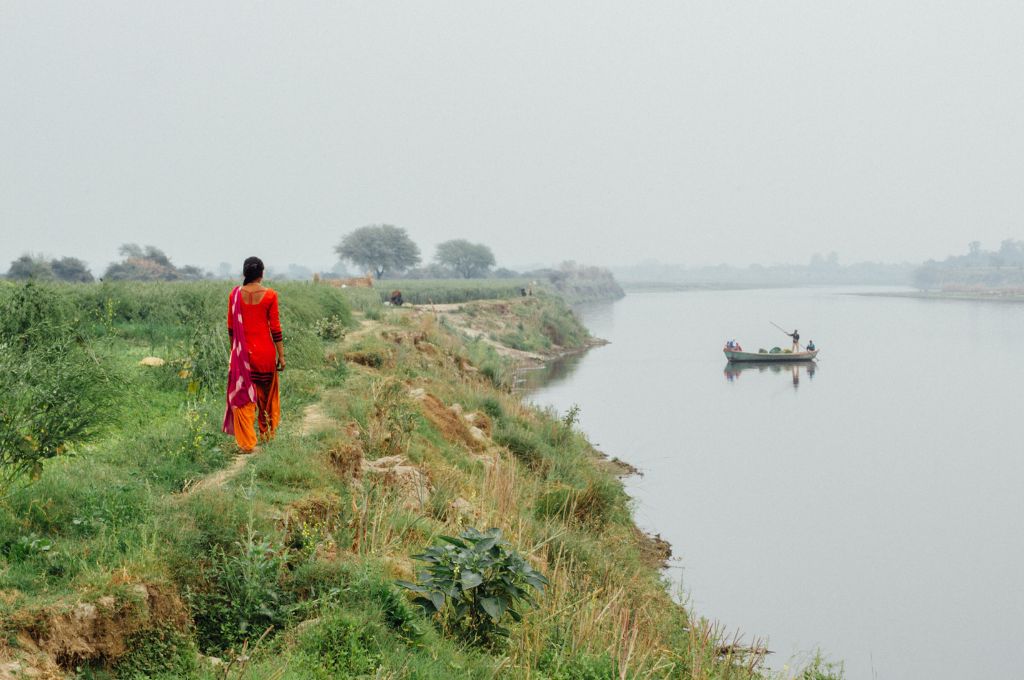Women in India are among the most socially and economically marginalised in the world. Their position has only worsened in the wake of the global pandemic, as evidenced by India falling from rank 133 in 2019 to 148 in 2021 in the Women Peace and Security Index, which measures women’s inclusion and security across the world. Existing data on women’s land ownership in India isn’t comprehensive, but it paints a rather dismal picture—although 80 percent of economically active women are in the agricultural sector, only 13 percent of them own agricultural land.
The importance of land rights as a means for women’s empowerment is fairly evident, as it provides women with financial security, shelter, income, and livelihood opportunities. But how does the existing legal framework concerning land in India further the cause of women’s land rights? And what are the existing gaps that need to be addressed? Based on the experiences of the Centre for Social Justice and the Working Group for Women and Land Ownership, this article presents a closer look at three land laws and their impact on women’s land rights.
Regulation of the distribution of land vested in the state
The Land Acquisition (Right to Fair Rehabilitation and Resettlement) Act, 2013, (LARR) and the Forest Rights Act, 2006, (FRA) are two integral laws in this realm. While the former involves the acquisition of land from citizens, the latter confers land rights upon them.
The LARR repealed the older Land Acquisition Act of 1984, which has been described as a draconian piece of legislation as it inflicted huge injustices on farmers in the name of development. The LARR instead made numerous progressive provisions, such as the need to obtain consent from affected families and a higher compensation rate.
The FRA is geared towards forest-dwelling Adivasi communities and recognises their right over forest land and resources, which they depend on for their livelihood, habitation, and other socio-cultural needs. These communities have been historically wronged by parties seeking to exploit the resource-rich forests that they rely on. Therefore, the FRA was designed to safeguard them.
These laws promote women’s land rights in a variety of ways.
1. The Land Acquisition (Right to Fair Rehabilitation and Resettlement) Act, 2013:
- In its definition of ‘affected families’, the LARR includes those who own the land being acquired and also those who depend on the land being acquired for their livelihood. Through its inclusion of those who rely on the land, the act brings within its ambit the significant percentage of landless women who earn their livelihood through farming, livestock rearing, etc. and entitles them to rehabilitation.
- Recognises widows, divorcees, and deserted women as separate families, which forwards the cause of women’s land rights as it recognises the rights of single women.
- The procedure concerning the titling of compensatory land is also more inclusive, as the LARR states that the compensatory land can be given in the names of both the husband and the wife of the affected family. This facilitates the joint ownership of land even if the original land may have been solely in the name of the husband.
2. Forest Rights Act, 2006:
- Recognises women’s right to land as equal to that of men by recognising individual forest rights through joint titles (that is, in the joint names of husband and wife).
- Grants individual forest rights to unmarried women, deserted women, and widows.
- Mandates that women be accorded a minimum of one-third representation in forest rights committees, which aid in the preparation of claims for forest rights and advise the gram sabha in the verification and approval of claims.

Regulation of the devolution of private land
Under India’s current system, different inheritance laws apply to each of the nation’s various religious communities in a bid to uphold religious freedom. The majority of Indian women fall within the ambit of the Hindu Succession Act, 1956, (HSA) that governs Hindus, Sikhs, Buddhists, and Jains.
Before the HSA was amended in 2005, only sons could inherit ancestral property. The amendment mandated that married and unmarried daughters must also receive an equal share in the family’s ancestral property. Additionally, it repealed the provision that only allowed female heirs to claim a partition of the dwelling if the male heirs decided to divide their share.
Prior to the amendment, the devolution of agricultural land was governed by archaic and highly discriminatory statewise tenurial laws. The amendment explicitly brought agricultural land within the ambit of the HSA as well.
Where the laws fall short
1. Inclusive, but not enough
Although the LARR recognises the rights of those who rely on but do not own land with regard to rehabilitation, it states that 70–80 percent of landowning families must consent to an acquisition for it to move forward. Thus, although the significant percentage of women who constitute non-landowning families would be rehabilitated, their consent is not sought in the first place. Landowning families are entitled to compensation, rehabilitation, and resettlement. But families that do not own land are only entitled to rehabilitation and resettlement. Even under the rehabilitation package, which includes a nominal cash package, year-long subsistence grant, housing unit, etc., these families are not entitled to land.
The LARR recognises the rights of single women as separate units of entitlement, but the manner in which the act distinguishes between landowning and non-landowning families makes the interpretation confusing. The act considers an “adult of either gender with or without spouse or children or dependents” as a separate family. Therefore, the unmarried adult daughter in a landowning family may be considered as a separate non-landowning family and would thus not be entitled to the same benefits that her parents receive as a landowning family.
2. Changing how communities live
Through our work, we have observed that the recognition of individual forest rights in areas that were largely collective-oriented has contributed to the emergence of an individualised world view. Operating as a collective offers greater social security to the women of these communities. Therefore, the spread of individualism has had a negative impact on them.
Access to and control over land-based natural resources have also come into question due to the demarcation of boundaries. This has led to strife between communities that have traditionally shared resources. During the lockdown, we visited a village in Gujarat’s Dang district that possessed a water resource traditionally used by all households around the village. Since the locals were instructed not to cross their village boundaries during the lockdown, people who had been accessing that water resource for generations were now told to go find water elsewhere.
Implementation challenges
Though a number of protections for women exist in the way the laws are currently framed, there are discrepancies in its implementation that hinder the cause of women’s land rights.
1. Societal pressures
In our experience of speaking with rural women who were governed by the HSA, we found that most of them are aware of the rights accorded by the act, such as daughters being entitled to parental property. Nevertheless, the social factors that prevented women from claiming their share still persist. For instance, women may fear that staking their claim might cause disharmony within the family, or they may be told that they must forgo their inheritance because a dowry was paid for their marriage. The conditions are more favourable for women in regions where women’s groups have a larger presence because of the time and energy that these groups have invested into changing prevailing patriarchal mindsets. But the women in these regions only account for a small proportion of those who are in need of better structural support.
2. Discretionary issues
The LARR states that compensatory land may be given in the joint names of husband and wife. However, the use of ‘may’ in the language of the provision leaves sufficient room for discretion and does not mandate that the wife’s name will be entered into the land record. As a result, it is quite likely that the title will remain solely in the name of the husband.
India’s scheduled tribes are governed by customary tribal law, which is more sensitive to the lived realities of the women of these tribes. For example, bigamy is permitted in the Adivasi community that we work with in southern Gujarat. Customary inheritance laws allow for the second wife to an equal share of the husband’s property. The rights of the second wife, which would otherwise not be considered, are thus recognised by virtue of this pluralism. However, our experience indicates that officials on the ground—who were once sensitive to the customs of these communities—often attempt to apply the HSA to them. As a result, they refuse to record the second wife’s name and deny her what she is entitled to.
3. State-specific agrarian laws vs the HSA amendment
Although the HSA amendment brought agricultural land within its ambit, it is in conflict with state-specific agrarian laws as the seventh schedule of the Constitution indicates that only states are empowered to legislate on agriculture. Although the Centre can legislate on succession, legislation on the succession of agricultural land remains disputed.
As a result, there have been conflicting high court and Supreme Court judgements on matters concerning the succession of agricultural land. While the Allahabad High Court held that the HSA would be superseded by state law, the Delhi High Court and Himachal Pradesh High Court recognised that state law would be overridden by the HSA. The Supreme Court also ruled that agricultural land would be covered by the HSA as per the amendment, but did not address the constitutional conflict between the act and tenurial laws.
Given that the exact legal position on this issue remains uncertain, agricultural property is still subject to being devolved as per archaic tenurial laws that are discriminatory towards women. Recognising the HSA’s power over state-specific laws should thus be a legislative and judicial priority.
How can existing gaps be filled?
1. Training and sensitisation
Women’s land rights are often not a priority for the bodies in charge of implementing land laws. For instance, the 2015 National Training Policy for Rural Development and Panchayati Raj, which guides the capacity-building programmes of the national and state institutes for rural development, does not contain material on women’s land rights. Given that these departments are responsible for training village-level government officials and those in charge of land revenue matters, the exclusion of women’s land rights from their training programmes is likely to influence whether women are able to receive their entitlements.
A greater degree of sensitisation to the cause of women’s land rights needs to also be engendered among officials. A review of the institution tasked with training judicial officers, the National Judicial Academy, reveals that although it conducted seven gender sensitisation training sessions and 130 workshops from 2018 to 2021, none included material on women’s land rights.1
The legal services authorities (LSAs) provide legal aid and training to marginalised groups, but their training manual only covers women’s land rights as part of a small section on property rights. Thus, there is a distinct need for greater education on the issue among those who are tasked with ensuring that women receive their entitlements.
2. Data and targeted programmes
The lack of gender disaggregated data on women’s land ownership is a significant barrier to determining the exact extent of women’s landlessness in India. Although NITI Aayog is working on digitising land records, there is no mention of collecting gender disaggregated data on land ownership. Given that ascertaining the extent of women’s landlessness is the first step in addressing the problem of women’s land ownership, the lack of efforts to accumulate accurate data reflects a lack of commitment to the cause.
The inclusion of gender disaggregated data on land ownership in the national indicator framework developed by the Ministry of Statistics and Programme Implementation will compel states to work towards addressing this gap. In particular, the provision of gender disaggregated data for aspirational districts, combined with targeted work and continued monitoring, will go a long way in addressing women’s landlessness in some of the most underdeveloped regions in the country.
In Gujarat, we tagged along with a government programme on updating land records and advocated for women’s names to be included in all of the land records that were being updated. If the LSAs were to similarly prioritise women’s land rights and devote their significant resources to it, they will be able to champion the cause more effectively.
Anahita Surya, Aditya Gujarathi, Gatha Namboothiri, Tanvi Singh, and Nupur Sinha contributed to this article.
—
Footnotes:
- Reena Patel, Gender and Land Rights in Changing Global Contexts, 2022.
—
Know more
- Read this article on the links between land ownership and women’s empowerment in India.
- Learn about the link between women’s land ownership and climate resilience.






